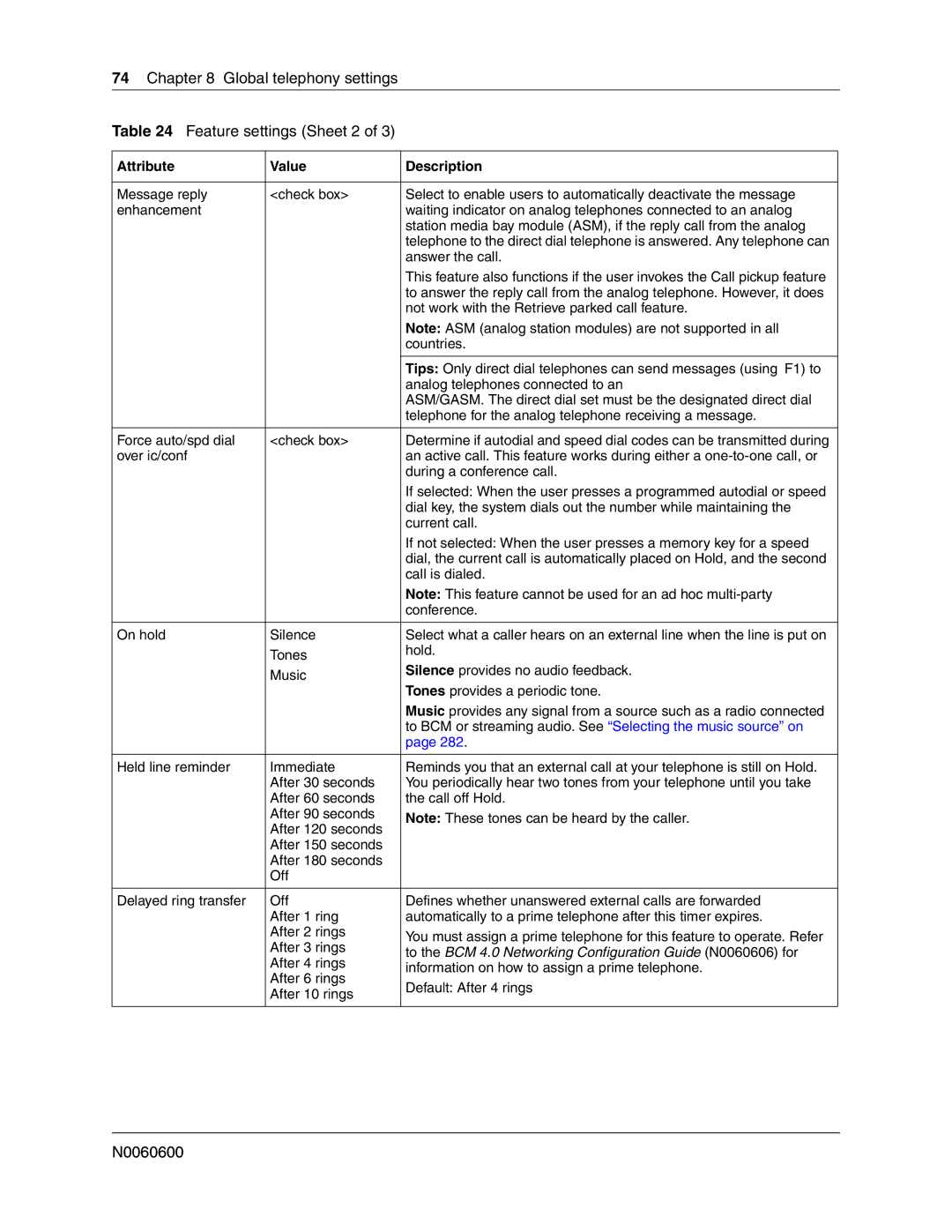
74Chapter 8 Global telephony settings
Table 24 Feature settings (Sheet 2 of 3)
Attribute | Value | Description |
|
|
|
Message reply | <check box> | Select to enable users to automatically deactivate the message |
enhancement |
| waiting indicator on analog telephones connected to an analog |
|
| station media bay module (ASM), if the reply call from the analog |
|
| telephone to the direct dial telephone is answered. Any telephone can |
|
| answer the call. |
|
| This feature also functions if the user invokes the Call pickup feature |
|
| to answer the reply call from the analog telephone. However, it does |
|
| not work with the Retrieve parked call feature. |
|
| Note: ASM (analog station modules) are not supported in all |
|
| countries. |
|
|
|
|
| Tips: Only direct dial telephones can send messages (using F1) to |
|
| analog telephones connected to an |
|
| ASM/GASM. The direct dial set must be the designated direct dial |
|
| telephone for the analog telephone receiving a message. |
|
|
|
Force auto/spd dial | <check box> | Determine if autodial and speed dial codes can be transmitted during |
over ic/conf |
| an active call. This feature works during either a |
|
| during a conference call. |
|
| If selected: When the user presses a programmed autodial or speed |
|
| dial key, the system dials out the number while maintaining the |
|
| current call. |
|
| If not selected: When the user presses a memory key for a speed |
|
| dial, the current call is automatically placed on Hold, and the second |
|
| call is dialed. |
|
| Note: This feature cannot be used for an ad hoc |
|
| conference. |
|
|
|
On hold | Silence | Select what a caller hears on an external line when the line is put on |
| Tones | hold. |
| Silence provides no audio feedback. | |
| Music | |
| Tones provides a periodic tone. | |
|
| |
|
| Music provides any signal from a source such as a radio connected |
|
| to BCM or streaming audio. See “Selecting the music source” on |
|
| page 282. |
|
|
|
Held line reminder | Immediate | Reminds you that an external call at your telephone is still on Hold. |
| After 30 seconds | You periodically hear two tones from your telephone until you take |
| After 60 seconds | the call off Hold. |
| After 90 seconds | Note: These tones can be heard by the caller. |
| After 120 seconds | |
|
| |
| After 150 seconds |
|
| After 180 seconds |
|
| Off |
|
|
|
|
Delayed ring transfer | Off | Defines whether unanswered external calls are forwarded |
| After 1 ring | automatically to a prime telephone after this timer expires. |
| After 2 rings | You must assign a prime telephone for this feature to operate. Refer |
| After 3 rings | |
| to the BCM 4.0 Networking Configuration Guide (N0060606) for | |
| After 4 rings | |
| information on how to assign a prime telephone. | |
| After 6 rings | |
| Default: After 4 rings | |
| After 10 rings | |
|
| |
|
|
|
